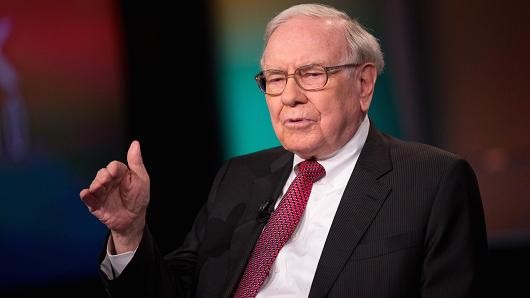Why Buffett is always betting big on bank stocks
Post on: 9 Апрель, 2015 No Comment

September 25, 2014 | Tim Mullaney, Special to CNBC.com
For a man who has been known to say some uncomplimentary things about bankers, Warren Buffet sure does love his bank stocks. By one recent analysis, the big banks and regional banks that Berkshire Hathaway has amassed in its portfolio of stocks adds up to a $50 billion market cap banking company—four of Berkshire Hathaways top 11 holdings in the stock market are in banks and other financial services companies.
For a little perspective, the combined market value of Buffetts bank stock holdings roughly equals the market cap of Deutsche Bank or PNC Financial and would rank eighth overall in terms of U.S. banks by size. That $50 billion banking company stocked away within Buffetts empire is also a sizable piece of Berkshire Hathaways approximately $350 billion valuation.
Jeff Kowalsky | Bloomberg | Getty Images
Goldman Sachs Group CEO Lloyd Blankfein (left) and Warren Buffett, CEO of Berkshire Hathaway
I dont think its remarked enough what a huge position that has become, said David Rolfe, chief investment officer of investment firm Wedgewood Partners, a Berkshire shareholder. He likely has the biggest stake in bank stocks of any U.S. investor other than a large mutual fund company.
Investors can learn a lot about the financial sector by taking a look at Buffetts approach. To begin with, by looking at the link between two of Warren Buffett s classic investing rules and financial stocks, its easy to see how banks have become a cornerstone of Berkshire Hathaway s holdings: One is to bet on industries that other companies need in order to do business and make the economy run, and the other is to be greedy when other people are scared.
A quarter of Berkshires operating company profits—income from Buffetts wholly-owned subsidiaries—come from insurance, which, like bank capital, is something other companies cant live without. This acumen is something Buffett has noted repeatedly through the years.
The sweet terms Buffett has extracted in snapping up stakes in financial companies at times of crisis, including American Express (way back in the 1960s), Bank of America and Goldman Sachs. which were the signature post-crash Buffett bailout bets, led to multibillion-dollar returns. But for ordinary investors looking to follow Buffetts banking bets, the most reliable path may be to follow his less opportunistic and more long-term bets on the sector: Wells Fargo. Berkshires biggest outside holding, and Minneapolis-based U.S. Bancorp .
Wells Fargo and U.S. Bancorp are so alike, they even make some of the same boasts, like citing data that explains why they fit into Berkshires emphasis on well-managed companies that it can own forever—Buffetts favorite word when referencing an investment time horizon.
At a Barclays conference in September, Wells Fargo and U.S. Bancorp presented virtually identical slides touting their rank as the first and second best-performing major U.S. banks in return on equity, return on assets and the so-called efficiency ratio, which analysts use to measure how effectively banks manage costs. By all three measures, U.S. Bancorp, the nations fifth-largest bank, is tops, and Wells Fargo is No. 2. They also pay out more of their earnings to shareholders, in dividends and share buybacks, than any bank other than Citigroup .
Both banks mostly eschew the razzle-dazzle of trading and investment banking to focus on bread-and-butter businesses, like mortgage and car lending, as well as Main Street–oriented commercial loans. U.S. Bancorp has nearly doubled its consumer-loan market share since 2007, the year after Buffett began building what is now about a 4 percent stake, and grabbed almost 7 percent of the market for middle-market syndicated loans, up from nearly zero before the recession. Wells Fargo is the nations largest lender in mortgages, small-business lending and auto loans.
In particular, both banks have worked on building up fee income to reduce their sensitivity to interest rates and credit risk. Wells Fargo generated 49 percent of its second-quarter revenue from fees, and U.S. Bancorp generated 46 percent, ranking 1 and 2 among top U.S. banks by the ratio of fee income to total assets.
Bank of New York Mellon. which has become one of Berkshires top 10 holdings in recent years even though it isnt similar in business mix to his other favorite banks, is a different way to approach the rate-sensitivity problem: 79 percent of BNY Mellons revenue is fee revenue from services, including investment management and bank custody and clearing, which can be described as showing a hyper-sensitivity to rate-based banking.
Given their focus on lending, the knocks on Wells Fargo and U.S. Bancorp have been persistently low-interest margins (the spread between what banks pay for deposits and collect on loans) and sluggish loan growth, said Raymond James analyst Anthony Polini. Loans should pick up in line with the resurgent U.S. economy, and the two banks spreads are still wider (i.e. better) than peer banks spreads, Polini said.
In a few years, when interest rates are more normal, loan growth is really going to be robust, U.S. Bancorp CEO Richard Davis told the Barclays conference. Were getting close to an inflection point.














